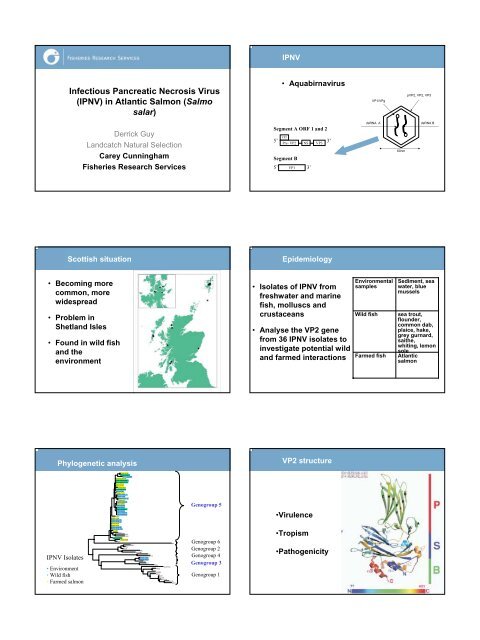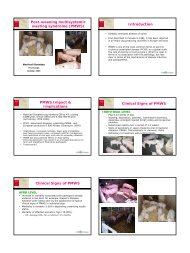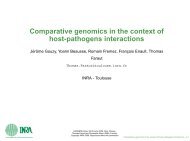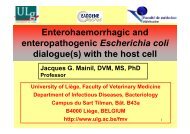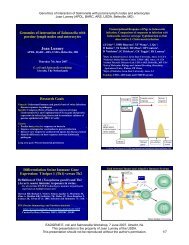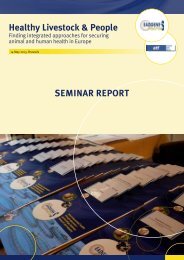Infectious Pancreatic Necrosis Virus (IPNV) in Atlantic Salmon (Salmo salar)
No Slide Title
No Slide Title
- No tags were found...
You also want an ePaper? Increase the reach of your titles
YUMPU automatically turns print PDFs into web optimized ePapers that Google loves.
0.02<br />
Jo Jo K<strong>in</strong>g: K<strong>in</strong>g:<br />
<strong>IPNV</strong><br />
<strong>Infectious</strong> <strong>Pancreatic</strong> <strong>Necrosis</strong> <strong>Virus</strong><br />
(<strong>IPNV</strong>) <strong>in</strong> <strong>Atlantic</strong> <strong><strong>Salmo</strong>n</strong> (<strong>Salmo</strong><br />
<strong>salar</strong>)<br />
• Aquabirnavirus<br />
VP1/VPg<br />
pVP2, VP2, VP3<br />
Derrick Guy<br />
Landcatch Natural Selection<br />
Carey Cunn<strong>in</strong>gham<br />
Fisheries Research Services<br />
Segment A ORF 1 and 2<br />
VP5<br />
5’ 3’<br />
Pre- VP2 NS VP3<br />
Segment B<br />
5’ VP1 3’<br />
dsRNA A<br />
60nm<br />
dsRNA B<br />
Scottish situation<br />
Epidemiology<br />
• Becom<strong>in</strong>g more<br />
common, more<br />
widespread<br />
• Problem <strong>in</strong><br />
Shetland Isles<br />
• Found <strong>in</strong> wild fish<br />
and the<br />
environment<br />
• Isolates of <strong>IPNV</strong> from<br />
freshwater and mar<strong>in</strong>e<br />
fish, molluscs and<br />
crustaceans<br />
• Analyse the VP2 gene<br />
from 36 <strong>IPNV</strong> isolates to<br />
<strong>in</strong>vestigate potential wild<br />
and farmed <strong>in</strong>teractions<br />
Environmental<br />
samples<br />
Wild fish<br />
Farmed fish<br />
Sediment, sea<br />
water, blue<br />
mussels<br />
sea trout,<br />
flounder,<br />
common dab,<br />
plaice, hake,<br />
grey gurnard,<br />
saithe,<br />
whit<strong>in</strong>g, lemon<br />
sole<br />
<strong>Atlantic</strong><br />
salmon<br />
Phylogenetic analysis<br />
VP2 structure<br />
<strong>IPNV</strong> Isolates<br />
• Environment<br />
• Wild fish<br />
• Farmed salmon<br />
2003-0818<br />
2004-0268-2<br />
2004-0268-9<br />
2003-0767-18<br />
2004-0576-MSF1<br />
2004-0576-SSF1<br />
2004-0576<br />
2002-0757<br />
2004-0421<br />
2004-0576-J2<br />
2003-0766<br />
1999-1114<br />
2003-0936-11<br />
2003-1363<br />
2003-0767-32<br />
1999-975<br />
2003-1360-63<br />
2003-0801<br />
2003-0749<br />
2003-0937<br />
2004-0268-S1<br />
2003-0002<br />
2003-1360-61<br />
2003-0936-23<br />
Fr10<br />
1999-1316<br />
2003-0936-19<br />
2003-0606-87<br />
2000-0434<br />
2000-0432<br />
2003-0606-88<br />
2003-0606-108<br />
La/79<br />
Fr21<br />
DPL<br />
OV2<br />
2004-0268-4<br />
1999-1848<br />
Sp<br />
He<br />
EEV<br />
PV<br />
E1S<br />
Ab<br />
CV-HB1<br />
C2<br />
C3<br />
2000-1288<br />
2004-0268<br />
Te<br />
C1<br />
ASV<br />
JA-ATCC<br />
West<br />
Dry<br />
VR299<br />
Reno<br />
Buhl<br />
91-137<br />
91-114<br />
64-93<br />
90-11<br />
Genogroup 5<br />
Genogroup 6<br />
Genogroup 2<br />
Genogroup 4<br />
Genogroup 3<br />
Genogroup 1<br />
•Virulence<br />
•Tropism<br />
•Pathogenicity
Virulence<br />
VP5<br />
• 217 important, threon<strong>in</strong>e<br />
associated with high<br />
virulence, prol<strong>in</strong>e with<br />
low virulence<br />
• Scottish isolates with<br />
prol<strong>in</strong>e have high<br />
virulence<br />
• Other factors have an<br />
effect on virulence<br />
–Host species<br />
– Orig<strong>in</strong> and<br />
environmental<br />
conditions<br />
217 221 247 Virulence<br />
Thr Thr/ Ala High<br />
Ala<br />
Thr Thr/ Thr High<br />
Ala<br />
Pro Thr Ala Low<br />
Pro Ala Ala Low<br />
Pro Ala Ala HIGH ?<br />
Segment A ORF 1<br />
VP5<br />
5’ 3’<br />
Pre- VP2 NS VP3<br />
Segment B ORF 2<br />
5’ VP1 3’<br />
• Truncated VP5 -<br />
virulent<br />
• Apoptosis<br />
Host response<br />
Vacc<strong>in</strong>ation<br />
• Transcriptome/ Proteome<br />
• Fish immunology<br />
• Carrier state<br />
• Protection<br />
• Experimental challenge<br />
• Licens<strong>in</strong>g<br />
• Vertical transmission<br />
• Vacc<strong>in</strong>ation<br />
Landcatch Family Unit<br />
Rank<strong>in</strong>g families<br />
Shetland West Coast Scotland (2)<br />
Green –<br />
resistant<br />
Orange –<br />
<strong>in</strong>termediate<br />
Red -<br />
susceptible
Gene Target<strong>in</strong>g: Marker Assisted Selection


